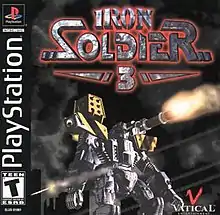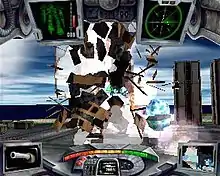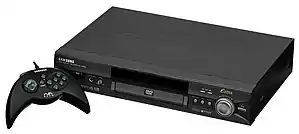Iron Soldier 3
Iron Soldier 3 is an open world first-person mecha simulation video game developed by Eclipse Software Design and originally published by Vatical Entertainment for the PlayStation on 20 June 2000 and was ported to the Nuon in 2001.[1] A sequel to Iron Soldier 2, it is the third and last installment of the Iron Soldier series.
| Iron Soldier 3 | |
|---|---|
 | |
| Developer(s) | Eclipse Software Design |
| Publisher(s) | |
| Designer(s) | Marc Rosocha |
| Programmer(s) | Gerhard Seiler Maik Guntermann |
| Artist(s) | Bleick Bleicken Daniel Hericks Gerhard Seiler |
| Composer(s) | Harald Riegler Peter Steinkellner |
| Series | Iron Soldier |
| Platform(s) | Nuon, PlayStation |
| Release | |
| Genre(s) | First-person shooter, mech simulator, open world |
| Mode(s) | Single-player, co-op, multiplayer |
Set after the events of the second game, players assume the role of an elite defense pilot taking control of the titular mech in order to complete tasks and protect areas that conforms the United Republic from attacks of the returning PENTA corporation. Iron Soldier 3 was conceived after release of the second entry and originally intended to be an exclusive first-party title by Sony Computer Entertainment for the PlayStation before the deal was cancelled, leading to both Vatical Entertainment and Telegames handling publishing duties instead while VM Labs published the Nuon port, with the two versions featuring various differences. Versions for PlayStation 2 and Xbox were in development but not released.
Iron Soldier 3 garnered mixed reception from critics and reviewers since its initial release on the PlayStation and later on Nuon, with many feeling divided in regards to several aspects such as the visuals, audio, presentation and gameplay, which was deemed by some as sluggish and comparing with other titles in the same genre such as Armored Core and Gungriffon.
Gameplay

Iron Soldier 3 is a mech simulation game with free-roaming elements that is primarily played in a first-person perspective like its predecessors, where the player controls a 42-foot-tall (13 m) robot to defend the United Republic, one of the last free countries left in a futuristic world from PENTA Industries, a large corporation that became powerful with the rapid industrialization of the world. There are several weapons to be found through the game such as machine guns, missiles, grenades and a flamethrower, among others to be collected and use. In addition to the standard titular robot, the player can pilot new mechs such as a smaller but faster chicken-walker type robot and a slower but more heavily armed walker. New gameplay modes have been added since Iron Soldier 2; although a single player campaign mode with 25 missions to complete was still included, there is also an arcade mode where the objective is to level every building in the area in the fastest time possible, in addition of a two-player mode.
Development
After Iron Soldier 2 was launched for the Atari Jaguar and Atari Jaguar CD, Eclipse Software Design founder Marc Rosocha began conversations with Sony Computer Entertainment in regards of developing for the PlayStation while former Atari Corporation vice president in third-party development Bill Rehbock, who was now part of Sony, managed to send development kits to Eclipse Software.[2] Rosocha stated that Eclipse was very close in obtaining a deal to publish Iron Soldier 3 as a first-party title but said deal was cancelled at the last minute, leading to the company signing another deal with both Vatical Entertainment and Telegames instead to handle publishing duties on PlayStation while a conversion for the Nuon was developed for VM Labs as well, which was overseen by former Atari Corp. employee Joe Sousa as its producer.[2][3] When developing the project, Rosocha and his team wanted to retain the series' established core gameplay and mechanics from the Jaguar that led criticism from reviewers for being slow.[2] The title made use of a proprietary game engine that featured several advanced special effects not commonly seen on PlayStation.[2] The CGI cutscenes were created by Johannes Graf, who would later go on to develop Sturmwind for Dreamcast.[4]
Release
Iron Soldier 3 was first launched for the PlayStation in North America by Vatical Entertainment on 20 June 2000, and later in Europe by Telegames during the same year. The game was published for the Nuon by VM Labs in 2001 as one of the eight games for the platform, but it was recalled at one point due to incompatibility with some DVD players, leading to the publisher releasing an estimated low run of demo discs being sent to the userbase of the system.[2][5] This version of the game features improved visuals and audio compared to the original PlayStation version, as well as other changes and additions.[6] Once the game was published in western regions, Eclipse was approached by a Japanese publisher to localize the game in the region, however, Rosocha declined the offer due to the proposed decision of making it play faster and enable mechs to fly.[2] A new version of the game titled Iron Soldier 3+ was in development for the PlayStation 2 and Xbox but it was cancelled.[2] In 2020, independent publisher Songbird Productions announced a 2021 re-release of the Nuon port limited to 100 copies.[7][8]
Reception
| Aggregator | Score |
|---|---|
| GameRankings | (PS1) 60%[9] |
| Publication | Score |
|---|---|
| AllGame | (PS1) |
| GameSpot | (PS1) 4.3 / 10[11] |
| IGN | (PS1) 6.8 / 10[12] |
| M! Games | (PS1) 68%[13] |
| Mega Fun | (PS1) 57%[14] |
| Video Games (DE) | (PS1) 58%[15] |
| The Electric Playground | (PS1) 4 / 10[16] |
Iron Soldier 3 received mixed reception since its release. The PlayStation version holds a 60% on the video game review aggregator GameRankings.[9]
References
- Return of the Borders – The Atari ST and the Creative People vol. 3. Microzeit Publishing. Archived from the original on 18 October 2019. Retrieved 18 October 2019.
- Charnock, Tom (March 2017). "The History Of: Iron Soldier". Retro Gamer. No. 165. Future Publishing. pp. 76–81.
- Wallett, Adrian (28 June 2019). "Joe Sousa (Atari) – Interview". arcadeattack.co.uk. Archived from the original on 29 June 2019. Retrieved 14 July 2019.
- Wallett, Adrian (14 September 2018). "Johannes Graf (Atari) – Interview". arcadeattack.co.uk. Archived from the original on 19 August 2020. Retrieved 12 July 2019.
- Manne, Kevin; Powell, Wes. "Iron Soldier 3 "Demo"". NUON-Dome. Archived from the original on 15 July 2019. Retrieved 14 July 2019.
- Manne, Kevin; Powell, Wes. "Iron Soldier 3". NUON-Dome. Archived from the original on 12 September 2019. Retrieved 14 July 2019.
- Forhan, Carl (2 December 2020). "It's the Most Wonderful Time of the Year part 1". Songbird Productions. Archived from the original on 23 December 2020. Retrieved 24 December 2020.
- Forhan, Carl (12 December 2020). "Iron Soldier 3 for NUON sign-up is open!". Songbird Productions. Archived from the original on 23 December 2020. Retrieved 24 December 2020.
- "Iron Soldier 3 for PlayStation". GameRankings. CBS Interactive. 2019. Archived from the original on 11 September 2018. Retrieved 11 September 2018.
- Woods, Nick (2000). "Iron Soldier 3 (PlayStation) - Review". AllGame. All Media Network. Archived from the original on 15 November 2014. Retrieved 12 July 2019.
- Lopez, Miguel (22 June 2000). "Iron Soldier 3 Review". GameSpot. CBS Interactive. Archived from the original on 31 January 2015. Retrieved 11 September 2018.
- Smith, David (27 June 2000). "Iron Soldier 3 Review". IGN. Ziff Davis. Archived from the original on 17 February 2016. Retrieved 11 September 2018.
- Mohr, David (November 2000). "Test - PS - Iron Soldier 3". MAN!AC (in German). No. 85. Cybermedia. p. 62. Archived from the original on 19 August 2020. Retrieved 16 August 2020.
- Döller, Georg (October 2000). "Test PlayStation - Iron Soldier 3". Mega Fun (in German). No. 97. Computec. p. 60. Archived from the original on 19 August 2020. Retrieved 14 July 2019.
- Olma, Alexander (November 2000). "Test - PlayStation - Iron Soldier 3". Video Games (in German). No. 108. Future-Verlag. p. 91. Archived from the original on 19 August 2020. Retrieved 14 July 2019.
- Sandhu, Mandip (2 October 2000). "Reviews - Iron Soldier 3". The Electric Playground. Archived from the original on 21 February 2001. Retrieved 11 September 2018.


